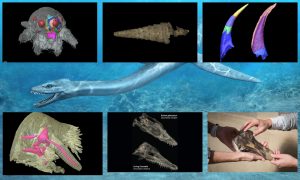
Digital and physical 3D models of a museum object from the Pitt Rivers Museum that visitors will be able to explore at a kiosk inside the gallery
In this interview, Georgina Brooke talks about the Physical and Virtual Show and Tell project, which will bring Virtual Reality to the Museum of Natural History.
This project is one of four GLAM Labs projects funded as part of this year’s IT Innovation Challenges round.
About the project
Technologies such as virtual reality (VR) and 3D printing allow natural history material to be investigated and presented in new ways. We want to explore and evaluate how these technologies might work for visitors in the context of learning and visitor experience in the Museum.
In this GLAM Labs project we will create an ‘experience station’ in the Museum to provide visitors with access to VR models of specimens that they can manipulate using their ‘virtual hands’, supported by digital annotations and interpretation. A touchscreen built in to the kiosk will also allow access to other digital content created by the Museum that is not currently available to in-gallery visitors. This station will be designed so that it can be used as ‘self-service’, but it will also serve as a base from which regular Spotlight Specimen ‘show and tell’ sessions can be run by staff. These facilitated sessions will allow staff to use 3D printed models (and specimens) related to the VR models available in the headset component of the station.
1. Please tell us a little bit about the team behind Physical and Virtual Show and Tell.
The project is jointly led by
- Scott Billings (Digital Engagement Officer, Oxford University Museum of Natural History),
- Georgina Brooke (Digital Content and Analysis Manager, Oxford University Museum of Natural History) and
- Stephen Taylor (Medical Research Council, Weatherall Institute of Molecular Medicine Group Leader).
We are also supported by
- Dr Paul Wilson (Research Fellow, WMG, the University of Warwick),
- Dr Imran Rahman (Deputy Head of Research, Oxford University Museum of Natural History),
- Dr Hilary Ketchum (Collections Manager; Palaeontology, Oxford University Museum of Natural History) and
- Peter Johnson (Museum Technician, Oxford University Museum of Natural History).
2. How did you come up with the idea for Physical and Virtual Show and Tell?
They were originally pitched as two separate ideas! Scott and Steve independently submitted ideas to the GLAM Labs call issued by the IT Innovation Challenges. It was then suggested that we merge ideas as they were similar. This worked out really well as we now have a team with strengths in museum operational management as well as technical leadership and experience of content delivery in VR.
3. Why did you choose to apply for the IT Innovation Challenges scheme?
At the Museum we were attracted by having a finite amount of time and money to test, in a discrete way, how we could implement VR in gallery and evaluate its usefulness. The scheme seemed a perfect fit with our desire to have a sandpit environment to evaluate what we wanted to be doing in the field of emerging tech.
4. What was the application process like for you? Which tips would you give future applicants?
It was time consuming, so I’d definitely recommend taking it seriously and thinking through a lot of the logistics of how the project will actually run upfront.
I think in our case we were fortunate that a lot of the typical unknowns (either ‘how will the museum like my idea?’ or ‘how do we technically implement it’) were solved for us as our project team was cross disciplinary and straddled museum people and tech folk. If you don’t have that, I’d strongly recommend getting buy-in and logistical know how from the Museum. It’s quite easy to come up with an idea that is un-implementable in a particular GLAM institution. Conversely, if you’re not technical, I’d recommend doing a lot of the upfront donkey work in terms of working out how the project will function. It means that your project plan will be much stronger and you’ll come across as a much stronger candidate at the pitch.
5. What are your plans for the next few months? How will you realise your project idea?
The next thing we need to do is get Paul Wilson in a room together with Stephen and the museum professionals who have 3D models (Imran and Hilary). This is the downside of having a big and dispersed team – finding a time and place that works for everyone is not simple.
Stephen has agreed to build a prototype of the in gallery furniture which will house the VR headset.
Once we’re a bit more confident of the 3D models we have, we need to identify what story we’re telling and how we can make best use of the potential of VR with these models.
6. How will the Physical and Virtual Show and Tell project bring benefit to students, staff and the University?
When you make a typical natural history museum visit, it can be difficult to get a sense of how specimens have been engineered, particularly if they are behind glass and/or very small, or – with things like bacteria- invisible to the naked eye. Our Physical and Virtual Show and Tell gives people access to these specimens, but at high resolution and giving people the ability to grapple with specimens in 360 degrees. During the course of the project, we want to interrogate the full potential of VR and experiment with peeling away layers of fossils or seeing the bullet hole in the head of the dodo.
Hopefully by the end of the project we will have a really good sense of what works and what doesn’t in a VR format, meaning we can continue to deliver top quality VR content. This should bring ongoing benefit to visitors to our Museum!
For more information about the project, please contact innovation@it.ox.ac.uk .